Food allergies are when the immune system reacts to certain foods, causing a range of symptoms from mild itching or swelling to severe reactions like difficulty breathing or anaphylaxis. Common food allergens include milk, nuts, shellfish, and eggs.
Managing food allergy primarily involves avoiding trigger foods, but it’s essential to know how to handle symptoms if they occur. Treatments like antihistamines can help with mild reactions, while epinephrine auto-injectors are crucial for emergencies.
Recommended Reading: Is Hay Fever Contagious? Causes, Symptoms, And Treatment
Treatment of Food Allergies (Treatment Option)
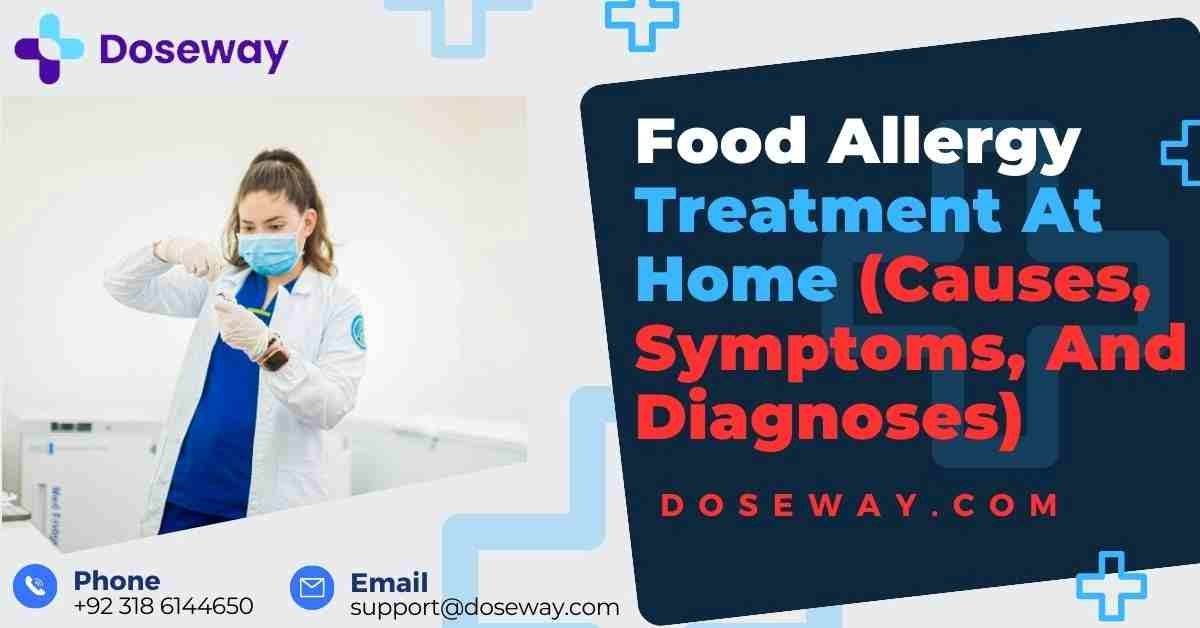
Table Of Contents
Recommended Reading: Natural Allergy Remedies For Eyes (Without Eye Drops)
What is a Food Allergy?
Food Allergy
A food allergy occurs when the immune system wrongly reacts to specific foods, leading to symptoms such as hives, swelling, or breathing issues. The body treats these foods as harmful, triggering an allergic response.
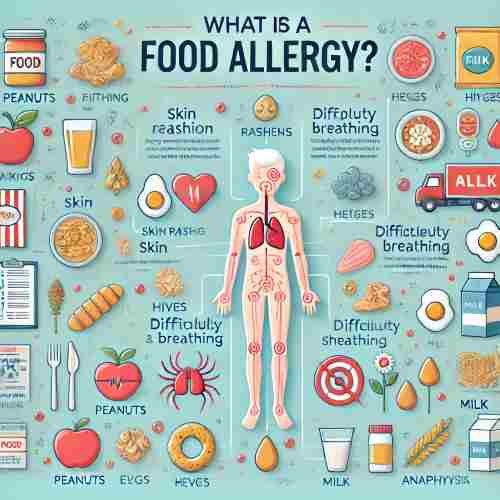
A food allergy happens when the body’s immune system reacts negatively to certain foods, mistaking them as harmful. This response can range from mild to severe. Mild reactions may include itching, skin rashes, or hives, while more serious symptoms could involve trouble breathing or even anaphylaxis, a life-threatening condition.
Food allergy occur because the immune system identifies specific food proteins as dangerous, even though they are harmless for most people. This reaction can happen within minutes or hours after eating the food that causes the allergy. Common causes include foods like peanuts, eggs, shellfish, and milk.
Food Allergies Treatment Option
Here are the best treatment options for Food Allergies:
- Antihistamine
- Tablet
- Syrup
- Injection
- Home Remedy
- Natural Remedy
Also, some tests are performed before starting the medication.
Recommended Reading: Best Medicine For Runny Nose And Sneezing (Causes And Treatment)
Top 5 Antihistamines For Food Allergies | Tablet For Food Allergies
Best Tablet For Food Allergy
Antihistamine for food allergy helps relieve symptoms like itching and hives. These tablets block histamine effects, offering relief from mild to moderate allergic reactions.
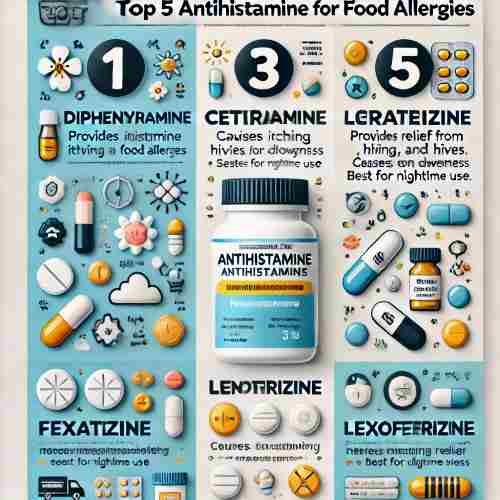
| Antihistamines for Food Allergies | Effectiveness | Notes |
|---|---|---|
| Diphenhydramine | Provides relief from itching, hives, and swelling caused by food allergies. | Can cause drowsiness; ideal for nighttime use but not suitable for daytime activities. |
| Cetirizine | Non-drowsy, long-lasting antihistamine for mild symptoms like hives and itching. | Second-generation antihistamine lasts longer than first-generation options like diphenhydramine. |
| Loratadine | Offers non-drowsy relief from sneezing, itching, and hives. | Recommended for daily use due to its long-lasting effect and minimal drowsiness. |
| Fexofenadine | Alleviates symptoms like itching and swelling without causing drowsiness. | Suitable for daytime use as it doesn’t interfere with alertness. |
| Levocetirizine | Provides quick relief from symptoms like itching and hives, with minimal drowsiness. | Works well for fast, long-lasting relief. |
Best Syrups For Food Allergies
Syrup For Food Allergy
The best syrups for food allergies help alleviate symptoms such as itching and swelling. These syrups provide quick relief from mild allergic reactions.
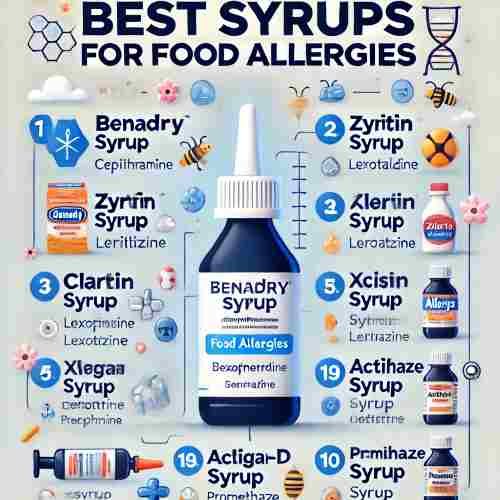
| Syrups for Food Allergies | Usage | Notes |
|---|---|---|
| Benadryl Syrup (Diphenhydramine) | Relieves itching, hives, and swelling caused by allergies. | May cause drowsiness; suitable for nighttime use. |
| Zyrtec Syrup (Cetirizine) | Provides long-lasting relief from allergy symptoms. | Non-drowsy; good for daytime use. |
| Claritin Syrup (Loratadine) | Helps with sneezing, runny nose, and itching. | Non-drowsy; ideal for daily use. |
| Allegra Syrup (Fexofenadine) | Treats hives and allergy symptoms without causing tiredness. | Safe for daytime activities. |
| Xyzal Syrup (Levocetirizine) | Fast relief from itching and swelling. | Minimal drowsiness; suitable for both day and night. |
| Deslor Syrup (Desloratadine) | Reduces symptoms like hives and sneezing. | Non-drowsy formula; effective for 24-hour relief. |
| Allegra-D Syrup | Combines antihistamine with decongestant to ease allergy symptoms and nasal congestion. | Non-drowsy; check for side effects related to decongestants. |
| Clistin Syrup (Chlorpheniramine) | Relieves runny nose, sneezing, and itching. | May cause drowsiness; often used for nighttime relief. |
| Actifed Syrup | Combines antihistamine and decongestant to treat food allergy symptoms and nasal congestion. | Can cause drowsiness; follow dosage instructions carefully. |
| Promethazine Syrup | Treats hives, swelling, and itching caused by food allergies. | Can cause drowsiness; best used under medical supervision. |
Recommended Reading: Allergy Medicine For Kids: Types, Uses, And Side Effects
Best Injections For Food Allergies
Injection For Food Allergy
The best injections for food allergies, like epinephrine, are used to treat severe allergic reactions, providing rapid relief. These injections are essential for managing life-threatening symptoms.
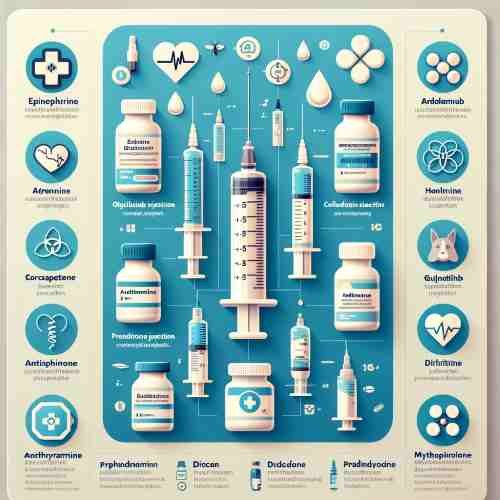
| Injection | Usage | Notes |
|---|---|---|
| Epinephrine (Adrenaline) | The most critical injection for treating anaphylaxis, is a severe allergic reaction. | Must be administered immediately in emergencies. EpiPen is a common auto-injector form. |
| Omalizumab (Xolair) | Helps reduce sensitivity to allergens in people with severe food allergies. | Administered regularly as part of an ongoing treatment plan. |
| Corticosteroid Injections | Reduces severe inflammation and allergic reactions, especially in emergency settings. | Used in hospitals to control serious allergic reactions. |
| Antihistamine Injections | Provides fast relief from mild to moderate allergic reactions, like hives and itching. | Blocks histamines that cause allergic symptoms. |
| Glucagon Injection | Used to reverse severe allergic reactions impacting blood sugar levels in emergencies. | Often used alongside epinephrine during anaphylactic reactions. |
| Hydrocortisone Injection | A steroid injection to reduce inflammation caused by allergic reactions. | Effective for controlling swelling and severe skin reactions. |
| Prednisolone Injection | Helps reduce severe allergic inflammation in emergency settings. | Administered in hospitals to treat serious reactions quickly. |
| Diphenhydramine Injection | An antihistamine injection that provides relief from allergic reactions when oral meds are unsuitable. | Can cause drowsiness; commonly used in urgent care. |
| Ranitidine Injection | Reduces allergic reactions affecting the stomach, such as nausea and vomiting. | Blocks histamine in the stomach, preventing acid-related symptoms. |
| Methylprednisolone Injection | A strong corticosteroid is used to treat severe allergic reactions, including respiratory symptoms. | Provides relief in emergency settings for life-threatening reactions. |
Best Creams for Food Allergy
| Cream Name | How It Helps | Key Ingredient |
|---|---|---|
| Aveeno 1% Hydrocortisone Anti-Itch Cream | Provides fast relief from itching and skin irritation caused by allergic reactions. | Hydrocortisone |
| Benadryl Extra Strength Itch Stopping Cream | Helps soothe itching, rashes, and skin discomfort due to allergies. | Diphenhydramine (Antihistamine) |
| Caladryl Skin Protectant Lotion | Reduces irritation, itching, and minor skin inflammation. | Calamine and Pramoxine |
| Eucerin Skin Calming Itch-Relief Treatment | Offers soothing relief for dry, itchy skin due to allergic reactions. | Oatmeal and Menthol |
| Hydrocortisone (Locoid, Micort-HC) | Helps reduce inflammation and itching caused by skin allergies. | Hydrocortisone |
| Desonide (DesOwen) | Mild corticosteroid cream that reduces itching and skin inflammation. | Desonide (Corticosteroid) |
| Mometasone | Treats inflammation, swelling, and itching from allergic skin reactions. | Mometasone (Corticosteroid) |
| Fluocinolone (Synalar) | Relieves itching, redness, and discomfort from allergic reactions. | Fluocinolone (Corticosteroid) |
| Triamcinolone | Treats moderate to severe skin reactions, including swelling and irritation. | Triamcinolone (Corticosteroid) |
| Betamethasone (Dermabet, Diprolene) | Strong steroid cream that reduces severe inflammation and itching. | Betamethasone (Corticosteroid) |
Recommended Reading: Allergy Medicine Dogs: Best Allergy Medicine For Dogs Licking Paws
Best Home Remedies for Food Allergies
| Home Remedy | How It Helps |
|---|---|
| Ginger Tea | Ginger has anti-inflammatory properties that help reduce nausea, indigestion, and inflammation caused by food allergies. |
| Honey | Consuming local honey helps build immunity to local allergens over time and may soothe allergic symptoms. |
| Apple Cider Vinegar | Balances stomach acid and promotes healthy digestion, reducing allergic reactions to certain foods. |
| Probiotics | Supports gut health by improving the balance of good bacteria, which can help manage food allergies. |
| Quercetin | A natural antihistamine found in fruits and vegetables like apples and onions, helping to control allergy symptoms. |
| Vitamin C | Strengthens the immune system and acts as a natural antihistamine to reduce allergic reactions. |
| Turmeric | Contains curcumin, a powerful anti-inflammatory agent that can help alleviate food allergy symptoms. |
| Aloe Vera Juice | Soothes the digestive system and reduces inflammation related to food allergies. |
| Peppermint Tea | Eases stomach discomfort and soothes digestive issues caused by food allergies. |
| Green Tea | Rich in antioxidants, it helps boost immunity and reduce allergic reactions. |
| Coconut Oil | Contains healthy fats that help soothe inflammation and promote healing in the gut caused by allergic reactions. |
| Oatmeal Bath | Soothes skin rashes and itching caused by food allergies when applied topically in a bath. |
Best Natural Remedies for Treating Food Allergies
Natural Remedies for Food Allergies
The best natural remedies for food allergy relief include consuming herbal teas, probiotics, and vitamin C-rich foods. These can help reduce symptoms and support immune health
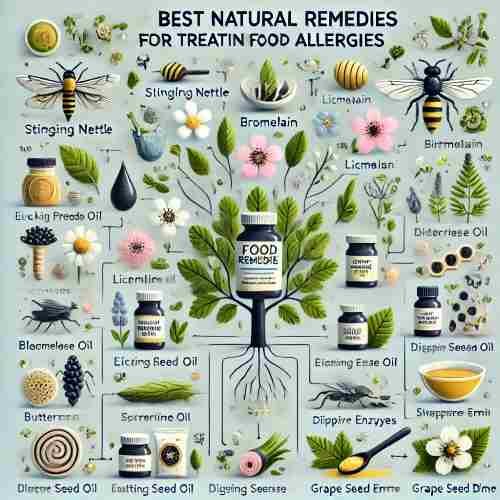
| Natural Remedy | How It Helps |
|---|---|
| Stinging Nettle | Acts as a natural antihistamine, helping to reduce allergic reactions and symptoms like itching and swelling. |
| Bromelain | An enzyme found in pineapples that helps reduce inflammation and swelling caused by food allergies. |
| Licorice Root | Known for its anti-inflammatory properties, it helps soothe the digestive system and reduce allergic reactions. |
| Spirulina | Boosts immune function and helps reduce allergic responses by lowering histamine levels. |
| Black Seed Oil | Helps strengthen the immune system and reduce inflammation, potentially easing food allergy symptoms. |
| Evening Primrose Oil | Contains essential fatty acids that help reduce inflammation and ease allergic reactions. |
| Butterbur | A natural antihistamine that helps alleviate symptoms like nasal congestion and itchy skin caused by allergies. |
| Digestive Enzymes | Aids digestion by breaking down food more efficiently, reducing the likelihood of allergic reactions. |
| Sarsaparilla | Helps detoxify the body and may ease symptoms of food allergies by improving overall immune function. |
| Slippery Elm | Soothes the digestive tract and helps reduce irritation caused by allergic reactions to certain foods. |
| Grape Seed Extract | Contains powerful antioxidants that can help reduce inflammation and allergic reactions. |
| Chamomile | Has soothing and anti-inflammatory properties that can help with skin irritation and digestive discomfort caused by food allergies. |
Recommended Reading: Best Allergy Medicine For Cats: Types, Uses, & Side Effects
Food Allergy Causes, Symptoms, And Diagnoses
Best Ways to Diagnose Food Allergies
Who to Diagnose Food Allergies
The best ways to diagnose food allergies include skin prick tests and blood tests, which help identify allergic reactions. Oral food challenges are also used for accurate diagnosis under medical supervision.
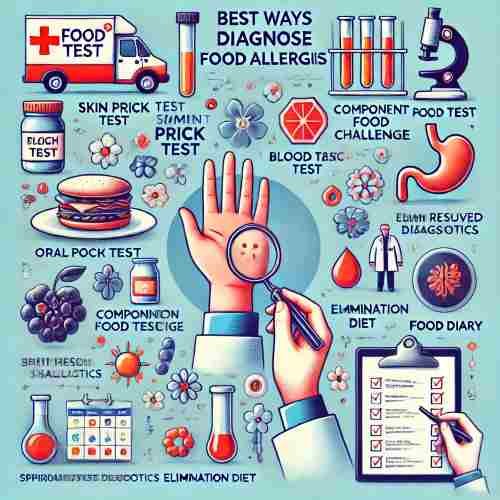
Here are the most effective methods for diagnosing food allergies, explained in simple and clear wording:
Skin Prick Test
A small amount of the suspected allergen is placed on your skin, and a tiny needle pricks the area. If a red bump appears, it suggests an allergic reaction to that substance.
Blood Tests
Blood tests check for specific antibodies called immunoglobulin E (IgE) that your body produces when reacting to allergens. Elevated IgE levels can indicate an allergy.
Oral Food Challenge
Considered the most accurate test, this involves consuming small amounts of the suspected food under medical supervision to monitor for a reaction.
Elimination Diet
In this method, you avoid suspected allergens for a period, then reintroduce them one by one to see if symptoms return. It helps identify the food causing the reaction.
Component-Resolved Diagnostics (CRD)
This test analyzes specific proteins within allergens to pinpoint exactly which one is causing the reaction. It can help differentiate between similar allergens.
Food Diary
Keeping a detailed food diary helps track what you eat and when symptoms occur. This can help identify patterns and hidden allergens.
Patch Testing
A patch containing the allergen is applied to your skin and left for 48 hours. It checks for delayed allergic reactions, typically for conditions like eczema.
Spirometry Test
This test measures lung function and may be used if food allergies cause respiratory symptoms like asthma.
Gastrointestinal Evaluation
If food allergy symptoms affect digestion, doctors may perform endoscopy or colonoscopy to rule out other conditions like irritable bowel syndrome or celiac disease.
Food Allergy Causes
Recommended Reading: Anti Allergy Medicine For Skin Itching (Uses & Side Effects)
Immune System Overreaction
Food allergies occur when the immune system mistakenly reacts to certain proteins found in specific foods. It wrongly identifies these proteins as harmful and responds by releasing chemicals like histamine, leading to allergy symptoms. The exact reason why some people develop food allergies isn’t fully understood, but a family history of allergies can increase the risk.
Common Food Allergens
Certain foods are more likely to cause allergic reactions. Some of the most common food allergens include:
- Cow’s Milk
- Eggs
- Fish
- Shellfish
- Peanuts
- Tree Nuts
- Wheat
- Soy
Genetic Factors
A family history of food allergies, asthma, or eczema can increase the likelihood of developing food allergies. If parents or siblings have allergies, there’s a greater chance that a person will also develop them.
Environmental Factors
Early exposure to allergens, such as through polluted air or chemicals, may cause food allergies in some individuals. Changes in diet, lifestyle, and environmental conditions can also impact how the body responds to certain foods.
Gut Health
A weak digestive system or imbalance in gut bacteria can sometimes make the body more susceptible to food allergies. When the gut doesn’t process food proteins properly, the immune system may overreact to them.
Cross-Reactivity
Some people may have allergies to similar proteins found in both foods and non-food allergens. For example, someone allergic to pollen might also react to fruits or vegetables that contain similar proteins, causing a reaction.
Recommended Reading: Best Allergy Medicine For Kids
Symptoms of Food Allergies
Common Symptoms of Food Allergies
Symptoms of food allergies can include itching, hives, swelling, and difficulty breathing. These reactions occur when the immune system responds negatively to certain foods.

Food allergies can cause various reactions in different parts of the body. These symptoms can range from mild to severe and may appear shortly after eating the allergenic food.
Skin Symptoms
- Hives: Red, raised, and itchy patches on the skin that can vary in size.
- Swelling: Swelling, particularly around the face, lips, eyes, and tongue, is a common sign of a food allergy.
- Itching and Redness: The skin may feel itchy, accompanied by redness or irritation.
- Flushing: Some individuals may experience a sudden redness or warmth in their skin.
Eye Symptoms
- Itching, Tearing, and Redness: Allergies often cause the eyes to become itchy, watery, and red.
- Swelling around the Eyes: Puffiness or swelling around the eyes, which may cause discomfort or blurry vision.
Nose and Mouth Symptoms
- Sneezing and Runny/Stuffy Nose: Allergy sufferers might experience frequent sneezing, along with a runny or blocked nose, much like the symptoms of a common cold.
- Swelling of the Lips or Tongue: The lips or tongue may become enlarged, making it uncomfortable to talk or eat.
- Increased Mucus Production: Excess mucus may build up, leading to a constant runny nose or difficulty clearing the throat.
Lung and Throat Symptoms
- Difficulty Breathing and Chest Tightness: Some people may experience shortness of breath or a feeling of pressure in the chest, which can be frightening.
- Coughing and Wheezing: Repeated coughing or a wheezing sound when breathing can indicate a more severe allergic reaction.
- Throat Swelling or Itching: The throat might swell or feel scratchy, making swallowing or breathing more difficult.
- Hoarseness or Voice Changes: The voice may become raspy or weak due to throat irritation or swelling.
Digestive Symptoms
- Vomiting and Diarrhea: The body may respond to food allergens by rejecting the food, leading to nausea, vomiting, or diarrhea shortly after eating.
- Abdominal Pain: Stomach cramps or pain can occur, sometimes accompanied by bloating.
Other Symptoms
- Anxiety and Confusion: A severe allergic reaction may cause anxiety, confusion, or a sense of impending danger.
- Dizziness or Fainting: A sudden drop in blood pressure can cause dizziness or fainting, which is a warning sign of anaphylaxis, a life-threatening reaction.
- Anaphylaxis: A person may experience anaphylaxis, a medical emergency that includes symptoms like difficulty breathing, a rapid drop in blood pressure, and loss of consciousness.
Side Effects of Food Allergies
Here are some common and severe side effects:
Skin Reactions
- Hives: Raised, itchy bumps that appear suddenly.
- Flushed Skin: Redness or warmth, especially on the face or neck.
- Swelling: Often seen on the face, lips, tongue, or eyelids.
- Itchiness: Itching around the mouth, throat, eyes, or skin.
Breathing Problems
- Wheezing: A whistling sound caused by narrowing airways.
- Coughing/Shortness of Breath: Persistent cough or trouble breathing.
- Noisy Breathing: Unusual sounds while breathing.
- Hoarse Voice/Difficulty Swallowing: Throat swelling or irritation affecting speech and swallowing.
Digestive Issues
- Vomiting and Diarrhea: The body may respond to allergens with vomiting or frequent bowel movements.
- Abdominal Cramps/Stomach Pain: Common discomfort in the stomach area.
- Nausea: Feeling queasy after eating certain foods.
Other Symptoms
- Dizziness/Lightheadedness: A sense of faintness, often indicating a severe reaction.
- Hay Fever-Like Symptoms: Sneezing, nasal congestion, runny nose, or itchy eyes.
- Itchy/Watery Eyes: Irritation in the eyes.
Anaphylaxis A Life-Threatening Reaction
Anaphylaxis is the most severe response to a food allergy and needs immediate medical attention. Symptoms include:
- Wheezing and Breathing Trouble
- Swelling of the Tongue, Lips, or Throat
- Circulation Problems: A rapid drop in blood pressure, causing fainting or confusion.
- Blue or Pale Skin and Lips
- Weak Pulse or Fainting
How to Prevent Food Allergies?
Avoid Allergens
- Stay away from foods that you know cause allergic reactions.
- Avoid foods without ingredient labels to prevent accidental exposure.
- Avoid foods with unknown ingredients that could contain allergens.
- Ask about ingredients when eating at restaurants or social gatherings.
Read Food Labels Carefully
- Always check ingredient lists on food packaging, both inner and outer.
- Look for “contains” labels for allergens like milk, eggs, peanuts, tree nuts, fish, shellfish, soy, and wheat.
- Check the label every time you purchase the product, as ingredients can change.
Be Prepared
- Keep emergency medications, like an epinephrine auto-injector, with you at all times.
- Educate family members, caregivers, and teachers about your allergies and what to do in case of an emergency.
Immunotherapy
- Oral Immunotherapy (OIT) can help build a tolerance to specific allergens by slowly introducing them in small amounts.
- Sublingual Immunotherapy (SLIT) works similarly, but the allergen is placed under the tongue to build tolerance.
Dietary Adjustments
- A low-fat diet rich in complex carbohydrates, such as beans, whole grains, and vegetables, may help reduce the severity of allergy symptoms.
Emergency Care for Food Allergies
Recognizing Anaphylaxis
Anaphylaxis is a severe allergic reaction needing urgent care. Symptoms include swelling, breathing difficulty, or fainting. Call emergency services and use an epinephrine auto-injector if available.
Food Safety Measures
Avoid cross-contamination by keeping allergenic foods separate. Always carry an epinephrine auto-injector and have an emergency plan to handle accidental exposure.
Food Allergy Treatment Benefits
- Lower Risk of Severe Reactions: Helps prevent serious allergic responses.
- Tolerate Accidental Exposure: Reduces the impact of accidental contact with allergens.
- Desensitization: Gradual reduction in sensitivity to specific allergens.
- Protection Against Cross-Contamination: Helps prevent serious reactions due to accidental allergen exposure.
Recommended Reading: Best Allergy Medicine For Dogs Licking Paws
FAQs
What is a Food Allergy?
A food allergy is an immune system reaction that occurs after eating a certain food. Even a small amount of the allergen can cause symptoms like hives, swelling, digestive problems, or more severe reactions like anaphylaxis.
What are common symptoms of a food allergy?
Common food allergy symptoms include itching, hives, swelling of the lips or tongue, abdominal pain, nausea, vomiting, and in severe cases, difficulty breathing or anaphylaxis.
What foods commonly cause food allergy?
The most common food allergens include peanuts, tree nuts, milk, eggs, fish, shellfish, soy, and wheat.
How is a food allergy diagnosed?
A food allergy is typically diagnosed through tests like a skin prick test, blood test, or an oral food challenge.
How can I prevent a food allergy reaction?
The best way to prevent a food allergy reaction is to avoid the allergenic food completely. Read food labels carefully and ask about ingredients when eating out.
Can food allergy go away over time?
Food allergy, especially in children (like milk or egg allergies), may be outgrown over time. However, allergies to peanuts, tree nuts, fish, and shellfish are more likely to be lifelong.
Recommended Reading: Hay Fever Causes, Symptoms, Diagnoses And Treatment
Conclusion
Food allergy can disrupt daily routines, but with the right knowledge and preventive measures, they are manageable. It’s important to steer clear of foods that trigger reactions, check food labels carefully, and always have emergency medications like epinephrine available.
If allergic reactions occur frequently, it’s crucial to consult a healthcare professional for proper diagnosis, such as skin or blood tests. While mild symptoms may be eased by natural or home remedies for Food allergy, professional medical advice is essential to safely and effectively manage food allergies.
Disclaimer
Commissions we earn from partner links on this page do not influence our content. Our editorial content is based on thorough research and insights from qualified medical professionals to ensure the highest standards of accuracy and reliability.
Information provided on Doseway is for educational purposes only. Your health and wellness are unique to you, and the products and services we review may not be suitable for your circumstances. We do not offer personal medical advice, diagnosis, or treatment plans. For specific advice, please consult with a healthcare professional. Doseway adheres to strict editorial integrity standards. To the best of our knowledge, all content is accurate as of the date posted, though offers and information may change. The opinions expressed are the author’s own and have not been influenced, approved, or endorsed by our partners.

 Cart is empty
Cart is empty
Add a Comment